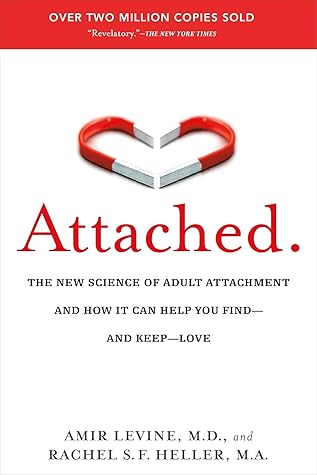More on this book
Community
Kindle Notes & Highlights
by
Amir Levine
Read between
August 24 - September 22, 2020
we’ve been programmed by evolution to single out a few specific individuals in our lives and make them precious to us.
Getting attached means that our brain becomes wired to seek the support of our partner by ensuring the partner’s psychological and physical proximity.
most people are only as needy as their unmet needs.
Numerous studies show that once we become attached to someone, the two of us form one physiological unit. Our partner regulates our blood pressure, our heart rate, our breathing, and the levels of hormones in our blood. We are no longer separate entities. The emphasis on differentiation that is held by most of today’s popular psychology approaches to adult relationships does not hold water from a biological perspective. Dependency is a fact; it is not a choice or a preference.
If you want to take the road to independence and happiness, find the right person to depend on and travel down it with that person.
secure base. It is the knowledge that you are backed by someone who is supportive and whom you can rely on with 100 percent certainty and turn to in times of need.
when our partners are thoroughly dependable and make us feel safe, and especially if they know how to reassure us during the hard times, we can turn our attention to all the other aspects of life that make our existence meaningful.
Having a partner who is inconsistently available or supportive can be a truly demoralizing and debilitating experience that can literally stunt our growth and stymie our health.
people with an anxious attachment style tend to jump to conclusions very quickly, and when they do, they tend to misinterpret people’s emotional state.
If you just wait a little longer before reacting and jumping to conclusions, you will have an uncanny ability to decipher the world around you and use it to your advantage. But shoot from the hip, and you’re all over the place making misjudgments and hurting yourself.
Activating strategies are any thoughts or feelings that compel you to get close, physically or emotionally, to your partner. Once he or she responds to you in a way that reestablishes security, you can revert back to your calm, normal self.
if you feel unsettled in a relationship situation, all that is required is a minimal reassurance from your partner—one
The more attuned you are to your partner’s needs at the early stages—and he or she to yours—the less energy you will need to expend attending to him or her later.
Even if your rational mind knows you shouldn’t be with this person, your attachment system doesn’t always comply.
people with anxious attachment styles are particularly susceptible to falling into a chronically activated attachment system situation.
the brains of people with an anxious attachment style react more strongly to thoughts of loss and at the same time under-recruit regions normally used to down-regulate negative emotions.
Each reaffirms the other’s beliefs about themselves and about relationships. The avoidants’ defensive self-perception that they are strong and independent is confirmed, as is the belief that others want to pull them into more closeness than they are comfortable with. The anxious types find that their perception of wanting more intimacy than their partner can provide is confirmed, as is their anticipation of ultimately being let down by significant others.
After living like this for a while, you start to do something interesting. You start to equate the anxiety, the preoccupation, the obsession, and those ever-so-short bursts of joy with love.
Next time you date someone and find yourself feeling anxious, insecure, and obsessive—only to feel elated every once in a while—tell yourself this is most likely an activated attachment system and not love!
Because you are used to equating an activated attachment system with love, you conclude that this can’t be “the one” because no bells are going off. You associate a calm attachment system with boredom and indifference.
first fully acknowledge your need for intimacy, availability, and security in a relationship—and to believe that they are legitimate.
The next step is to start expressing your needs.
by expressing those needs you achieve two goals. First, you are being your authentic self,
Second and no less important, once you are your authentic self, if your partner is incapable of meeting your genuine needs, you can determine that early on.
Amir suggested spelling things out point-blank, as in “I love you very much; I need to know that you are there for me all the time. I want to know I can talk to you every day and not just when it’s convenient for you. I don’t want to have to cover up my wish to spend time with you for fear of driving you away.”
once your attachment system is activated, you begin to crave the other person’s closeness and will do anything in your power to make it work even before you really get to know him/her and decide whether you like that person or not!
Remind yourself that you might feel bored at first—after all, there is less drama when your attachment system isn’t activated.
Even though it’s important for each of us to be able to stand on our own two feet, if we overrate self-reliance, we diminish the importance of getting support from other people, thus cutting ourselves off from an important lifeline.
Only after they broke up, and she no longer felt threatened by the high level of intimacy, did her defense strategies lift. She was then able to get in touch with the underlying feelings of attachment that were there all along


